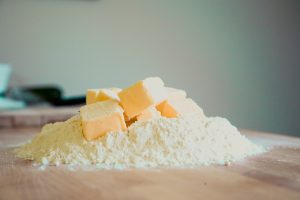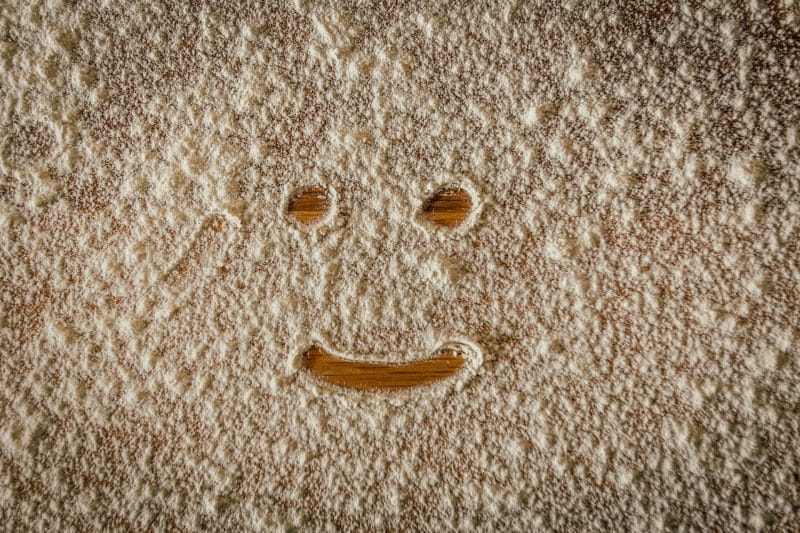Gluten-Free Flour
This is where it all starts. The foundation of everything that has been my greatest triumph all the way down to my worst “oh no, don’t eat that” kitchen moment. Understanding different gluten-free flours, their non-gluten proteins, which ones are whole grains & which ones are just starches, and when to use them, will set the stage for any gluten-free (GF) baker to become master of this craft. A true Pavarotti of GF bread & pastry. Unfortunately, like Pavarotti, most of the time it seems unnecessary and just plain showing-off. Let’s face it, most home bakers never want to get into that level of detail with their flour. Gluten bakers have it easy because everything is pre-mixed/pre-labeled for direct use. Before my GF days, I would look at a recipe and know exactly what I needed to use because it’s literally in the name, All-Purpose Flour, Bread Flour, Cake Flour, Self-Rising Flour, etc. That, in my opinion is the biggest hurdle in overcoming errors when converting recipes into their GF counterparts.
We look at the store shelves and see things like, White Rice Flour, Cassava Flour, Sorghum Flour & Tapioca Starch. Which one of those replaces self-rising flour again? The last thing most home bakers want to deal with is turning Grandma’s classic banana bread recipe into a chemistry experiment, not to mention, after 2 hours labor you’ve made the equivalent of inedible kitchen concrete. I will save you this frustration.
I’ve spent years reading books about these flours, when, and how to use them. I’ve experimented with different GF Flour blends, both home blended as well as store bought—all with mixed results. Anyone who has ever dipped their toes into the pool of GF baking has most likely started exactly in the same place that I did—King Arthur’s Gluten-Free All Purpose Flour Blend. Let me preface by stating, I am a huge fan of King Arthur as a company. I even have acquaintances that have been to their facility in Vermont for baking classes, and they can’t say enough great things about the place. I found their GF All-Purpose Blend and immediately thought—this will be easy! Not the case, and it was definitely not a 1:1 swap in my classic pancake recipe. That morning’s batch of pancakes were very appropriately nick-named “Fog Cutter Cakes” due to their heavy, thick, and gummy texture—totally inedible. To be fair, this was likely user error on my part, and there is probably some technique or fine print that I missed on the package somewhere—but that is exactly the point here. Most of us, just want to grab that magical “All-Purpose Blend” again, and convert our recipes perfectly, every time. I believe I can help.
The true All-Purpose Gluten-Free flour blend is not a mythical unicorn. It’s a blend of both refined and whole grain rice flours, starches, and stabilizers. The trick to unlocking GF magic here is the ratios of these items and knowing how to put them together to make a blend ideal for your taste and texture. Let’s compare some of the blends that I’ve experimented with throughout my trials. I’ve compartmentalized each of the ingredients and color coded them by type to correlate with the pie chart.
Jeanne Sauvage; “The Art of Gluten-Free Baking”
Jeanne is a GF Baker, Blogger, Academic, Teacher & Author, and I’m sure this list goes on. I have her second book “Gluten-Free Wish List”, and it has been at my side the longest on this journey. I cannot recommend this book more. Her GF Flour Blend is something she developed based on a blend from Bette Hagman, the “Gluten-Free Gourmet.”
|
Jeanne’s Blend |
Grams |
Percent |
Type |
Percent by type |
|
white rice flour |
205 |
30.6 |
Refined Grain |
55.2 |
|
sweet white rice flour |
165 |
24.6 |
Refined Grain |
|
|
brown rice flour |
170 |
25.4 |
Whole Grain |
25.4 |
|
tapioca flour |
120 |
17.9 |
Starch |
17.9 |
|
xanthan gum |
≈10 |
1.5 |
Stabilizer |
1.5 |
Jeff Hertzberg, MD, and Zoë François; “Gluten-Free Artisan Bread in Five Minutes a Day”
These two accomplished authors have a small library dedicated to gluten free baking, and their books are filled with precision and dedication. This is another book that I would recommend for anyone exploring GF baking. I’ve broken down their GF blend by type as well and used the same color-coding scheme as above for reference.
|
GFAB in 5 Min. a Day |
Grams |
Percent |
Type |
Percent by type |
|
White Rice Flour |
1020 |
51.9 |
Refined Grain |
51.9 |
|
Sorghum Flour |
455 |
23.2 |
Whole Grain |
23.2 |
|
Tapioca Flour |
225 |
11.5 |
Starch |
22.9 |
|
Potato Flour |
225 |
11.5 |
Starch |
|
|
Xanthan Gum |
40 |
2.0 |
Stabilizer |
2.0 |
Notice those percentages? Even though these two blends use almost completely different ingredients, when you categorize the ingredients by the basic type, similarities begin to emerge. Both blends contain approximately between 52 – 55% of a refined source(s), as well as between 23 – 25% of a whole grain source(s). They also contain similar levels of starches as well as stabilizer.
I’ve found this similar pattern in some of the GF blends from mainstream flour companies as well. Both King Arthur Flour as well as Bob’s Red Mill now offer 1-1 Gluten-Free flour blends and assuming they follow the semi-universal ingredient list “order by weight %” format (most to least), they are as follows:
King Arthur GF Measure for Measure:
Rice Flour, Whole Grain Brown Rice Flour, Sorghum Flour, Tapioca Starch, Potato Starch, Cellulose, Vitamin & Mineral blend, Xanthan Gum, Cellulose Gum
Bob’s Red Mill 1 – 1 Baking Flour:
Sweet White Rice Flour, Whole Grain Brown Rice Flour, Potato Starch, Whole Grain Sorghum Flour, Tapioca Starch, Xanthan Gum
You can see from these ingredients, assuming from largest to smallest quantity, these also list the refined sources first, followed by the whole grain sources, followed by the starches, and lastly, the stabilizers.
This pattern of basic GF flour types is how I developed my own GF flour blend, which I refined further simply by taste. I mixed & matched different refined flour types, different whole grain flour types, different blends of starches until I had a flour blend that provided me with the most general, all-purpose flour blend that I could drop into any recipe I found. People often cannot believe they are eating GF baked goods & breads, and that is exactly the point.
Here is The Gluten-Free Baker, gluten-free flour blend:
|
The Gluten-Free Baker Blend |
Grams |
Percent |
Type |
Percent by type |
|
white rice flour |
350 |
28.0 |
Refined Grain |
54.4 |
|
sweet white rice flour |
330 |
26.4 |
Refined Grain |
|
|
brown rice flour |
300 |
24.0 |
Whole Grain |
24.0 |
|
tapioca flour |
140 |
11.2 |
Starch |
20.0 |
|
modified tapioca flour |
110 |
8.8 |
Starch |
|
|
xanthan gum |
20 |
1.6 |
Stabilizer |
1.6 |
A note about why I selected these specific items
Sweet White Rice Flour, aka Glutinous Rice Flour
I have included the use of sweet white rice flour in my blend specifically due to its nature of being sticky—unlike the name suggests, not because it’s sweet, nor is it glutinous. This flour is derived from a short-grain white rice that can be annoyingly sticky if you have ever worked with it. Think about sushi, or rice from your local Japanese restaurant and imagine making a flour from that. I find this flour really adds a nice texture and mouth feel to your bakes. This flour is produced by Bob’s Red Mill, Koda Farms (Mochiko), and Erawan Marketing Co, LTD. I have used all three with remarkable success, and all three are available on Amazon, or in specialty stores.
I know, I know—people see the word “modified” and assume GMO, or genetically modified ingredient. That assumption is incorrect in this case. Modified tapioca starch is simply normal tapioca starch, processed in a way that coaxes different properties from the ingredient. It makes the starch perform in a way that allows for easier expansion in bread crumb. I use this in a proportion that aides in extra lift in my bread recipes, while not affecting my cakes or pastries. This is easily available on Amazon under the brand Expandex®, but you may also find this in specialty stores.

Gluten-Free Flour Blend
- Serving Size: Little Over 8 Cups
- Total Time: 10 minutes
Ingredients
- 350 grams White Rice Flour
- 330 grams Sweet White Rice Flour
- 300 grams Brown Rice Flour
- 140 grams Tapioca Flour
- 110 grams Modified Tapioca Flour (Expandex®)
- 20 grams Xanthan Gum
Directions
- Weigh each of the gluten-free flour ingredients using a kitchen gram scale, and put into a larger container (preferably air-tight with a lid)
- After adding everything into the container, mix well, or apply the lid and shake vigorously.
- Once all of the ingredients are well blended, store in a cool place, or in the refrigerator for freshness.

